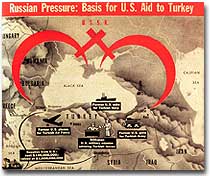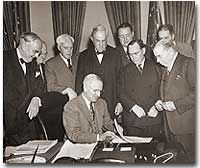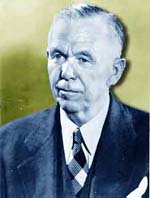52c. Containment and the Marshall Plan

This illustration from the July 16, 1948, U.S. News magazine shows the beginnings of American containment policy. The U.S. is seen sending troops, advisors and weapons to Turkey in hopes that the country will resist communism and remain democratic.
Communism was on the march.
When the Red Army marched on Germany, it quickly absorbed the nearby nations Estonia, Latvia, and Lithuania into the Soviet Union. Soon communist forces dominated the governments of Romania and Bulgaria. By the fall of 1945, it was clear that the Soviet-backed Lublin regime had complete control of Poland, violating the Yalta promise of free and unfettered elections there. It was only a matter of time before Hungary and Czechoslovakia fell into the Soviet orbit. Yugoslavia had an independent communist leader named Tito.

When Harry Truman approved the Marshall Plan in 1948, his official statement said, "Few presidents have had the opportunity to sign legislation of such importance."
And now Stalin was ordering the creation of a communist puppet regime in the Soviet sector of occupied Germany. How many dominoes would fall? United States diplomats saw a continent ravaged by war looking for strong leadership and aid of any sort, providing a climate ripe for revolution. Would the Soviets get all of Germany? Or Italy and France? President Truman was determined to reverse this trend.
Greece and Turkey were the first nations spiraling into crisis that had not been directly occupied by the Soviet Army. Both countries were on the verge of being taken over by Soviet-backed guerrilla movements. Truman decided to draw a line in the sand. In March 1947, he asked Congress to appropriate $400 million to send to these two nations in the form of military and economic assistance. Within two years the communist threat had passed, and both nations were comfortably in the western sphere of influence.
A mid-level diplomat in the State Department named George Kennan proposed the policy of containment. Since the American people were weary from war and had no desire to send United States troops into Eastern Europe, rolling back the gains of the Red Army would have been impossible.

In July 1947 a majority of the American public had never even heard of the Marshall Plan. But to win passage in Congress, the Truman administration needed strong public support, so it launched a massive public relations campaign.
But in places where communism threatened to expand, American aid might prevent a takeover. By vigorously pursuing this policy, the United States might be able to contain communism within its current borders. The policy became known as the Truman Doctrine, as the President outlined these intentions with his request for monetary aid for Greece and Turkey.
In the aftermath of WWII, Western Europe lay devastated. The war had ruined crop fields and destroyed infrastructure, leaving most of Europe in dire need. On June 5, 1947, Secretary of State George Marshall announced the European Recovery Program. To avoid antagonizing the Soviet Union, Marshall announced that the purpose of sending aid to Western Europe was completely humanitarian, and even offered aid to the communist states in the east. Congress approved Truman's request of $17 billion over four years to be sent to Great Britain, France, West Germany, Italy, the Netherlands and Belgium.

In a speech to Harvard University in 1947, Secretary of State George C. Marshall proposed that a post-war European aid program be initiated. Less than a year later, the Marshall Plan was a reality.
The Marshall Plan created an economic miracle in Western Europe. By the target date of the program four years later, Western European industries were producing twice as much as they had been the year before war broke out. Some Americans grumbled about the costs, but the nation spent more on liquor during the years of the Marshall Plan than they sent overseas to Europe. The aid also produced record levels of trade with American firms, fueling a postwar economic boom in the United States.
Lastly and much to Truman's delight, none of these nations of western Europe faced a serious threat of communist takeover for the duration of the Cold War.






